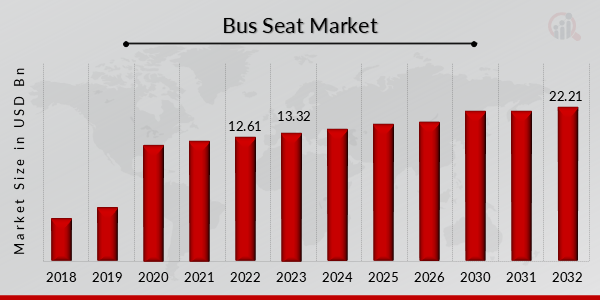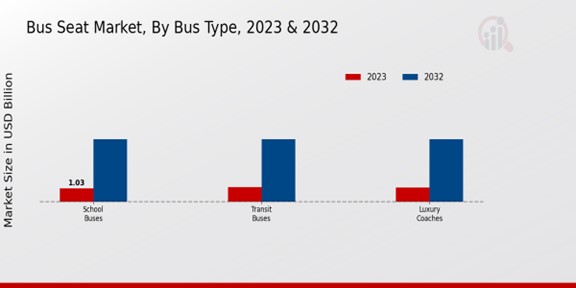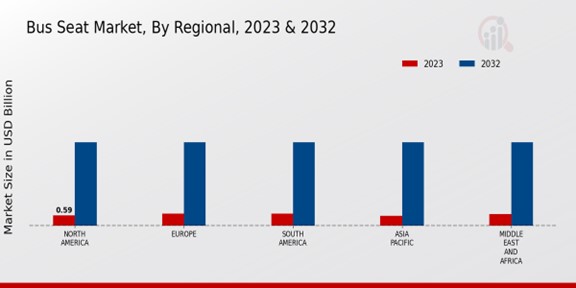Bus Seat Market Overview
As per MRFR analysis, the Bus Seat Market Size was estimated at 12.61 (USD Billion) in 2022. The Bus Seat Market Industry is expected to grow from 13.32 (USD Billion) in 2023 to 22.21 (USD Billion) by 2032. The Bus Seat Market CAGR (growth rate) is expected to be around 5.8% during the forecast period (2024 - 2032).
Key Bus Seat Market Trends Highlighted
Advanced technologies, increased focus on passenger comfort, and rising urbanization drive the Bus Seat Market. The demand for luxury and ergonomic seats is growing as bus travel becomes more popular. Additionally, the adoption of sustainable materials and designs is gaining traction to meet environmental concerns. Technological advancements, such as seat sensors and integrated entertainment systems, enhance passenger experience and safety. The integration of IoT (Internet of Things) allows for remote monitoring and data analysis, optimizing seat utilization and reducing maintenance costs. The expansion of public transportation networks and the growing popularity of intercity bus travel present opportunities for market growth. The increasing number of bus passengers creates a demand for comfortable and reliable seating solutions. Furthermore, the trend toward lightweight and cost-effective seats is expected to drive market growth, particularly in emerging markets.

Source: Primary Research, Secondary Research, MRFR Database and Analyst Review
Bus Seat Market Drivers
Rising Demand for Enhanced Passenger Comfort and Safety
The development of more comfortable and secure bus seats is in high demand, and this is caused by the higher focus on the passenger experience. Thus, the necessity of seats designed in accordance with high ergonomic standards remains one of the most valuable because it is crucial for the majority of passengers to have enough legroom and to be able to adjust the seats. Moreover, the issue of safety is another important aspect that should be discussed because the need to survive without serious traumas in the case of collision is the priority for every person, and a bus seat with special impact-absorbing features along with the headrests and seatbelts is obligatory.That is why both the current interest of passengers and the existing strict safety regulations require fast improvements and the efficient development of the Bus Seat Market Industry.
Technological Advancements and Innovation
Technology is driving the revolution that has become an everyday occurrence in the development of the Bus Seat Market Industry. With its help, various possible solutions have been made available to integrate smart technologies. The latter refers more especially to implementing sensors, connectivity, and infotainment systems that maximize the comfort of passengers riding buses. Smart bus seats make use of these widgets individually for each passenger, ensuring comfort and personal settings. At the same time, it becomes possible to track the bus in real-time or even provide access to online entertainment for costing the city or other regions. Lightweight materials and innovative designs allow the product to be made more comfortable, practical, and durable.
Increasing Government Regulations and Standards
Government regulations and safety standards are some of the crucial drivers shaping the Bus Seat Market Industry. Stringent regulations have been put in place concerning the safety of the passengers, the emissions of the bus, and the overall accessibility of the bus, which have urged the growth of bus seats. Governments are putting measures in place to improve the public transport system and encourage sustainable modes of mobility. Thus, the introduction of more buses and the enforcement of regulations will definitely result in the growth of the bus seat market industries.
Bus Seat Market Segment Insights
Bus Seat Market Bus Type Insights
The Bus Seat Market is segmented by Bus Type into School Buses, Transit Buses, and Luxury Coaches. The School Buses segment is predicted to be the biggest, with a value of USD 1.23 billion for the year 2023. This segment will grow at a CAGR of 4.2% between 2023 and 2032 to be valued at USD 1.68 billion in 2032. The Transit Buses segment is forecast to be the fastest-growing segment in the Bus Seat Market. This segment will grow at a CAGR of 4.8% between 2023 and 2032. This growth is due to the rising demand for public transport in urban areas.
This segment will have a value of USD 1.32 billion in 2032. The Luxury Coaches segment is expected to have a market share for 2023, with a value of USD 0.67 billion. This segment will grow at a CAGR of 4.1% between 2023 and 2032 to be valued at USD 0.91 billion in 2032. The Bus Seat Market will be driven by the rising demand for public transport, the increasing number of school-going children, and the burgeoning popularity of luxury transportation. This market will be further propelled by the increasing of technologies such as heated and cooled seating systems, infotainment systems, headrests, and others.

Source: Primary Research, Secondary Research, MRFR Database and Analyst Review
Bus Seat Market Seating Mechanism Insights
Seating Mechanism is a significant market segment in the Bus Seat Market. Fixed Seats are the most common type of seating mechanism; they constituted over 60% of the market revenue in 2023. Fixed seats are usually installed on school buses, public transportation buses, and other buses where the passengers are not required to recline or swivel. Reclining Seats are the second most popular seating mechanism, constituting over 30% of the market revenue in 2023.
Reclining seats are typically installed in luxury buses, sleeper buses, and other buses, and passengers are expected to have more comfort and support. Swivel Seats are the rarest type of seating mechanism, and they constituted less than 10% of the market revenue in 2023. Swivel Seats are typically installed in tour buses, shuttle buses, and other buses, and the passengers should have the ability to face each other or be in front of the bus. The market will be worth USD 4.8 billion by 2032. The growth will be driven by the increasing number of buses installed in developing countries and the growing popularity of luxury buses.
Bus Seat Market Upholstery Material Insights
The Bus Seat Market segmentation by Upholstery Material includes Leather, Fabric, and Vinyl. The leather segment is expected to lead the market, accounting for a majority of the market share in 2023, and it is projected to continue its dominance throughout the forecast period. The high preference for Leather is due to its durability, aesthetics, and comfort. The fabric segment is expected to hold a significant share of the market owing to its cost-effectiveness, breathability, and wide range of colors and patterns that match different bus interiors. The Vinyl segment is anticipated to have a steady growth rate during the forecast period, primarily driven by its affordability, durability, and ease of cleaning. Technological advancements and the increasing demand for luxury and comfort in buses are expected to drive the growth of the Bus Seat Market over the coming years.
Bus Seat Market Regional Insights
The regional segmentation of the Bus Seat Market offers valuable insights into the market's geographical distribution and growth potential. North America holds a significant market share, driven by the presence of major bus manufacturers and a well-established transportation infrastructure. Europe is another key region with a strong emphasis on luxury and comfort in bus seating. The APAC region is projected to witness substantial growth over the forecast period, owing to the increasing demand for public transportation and the expansion of the automotive industry. South America and MEA also present growth opportunities, albeit on a smaller scale. These regional insights are crucial for businesses operating in the Bus Seat Market, enabling them to tailor their strategies and cater to the specific needs of each region.

Source: Primary Research, Secondary Research, MRFR Database and Analyst Review
Bus Seat Market Key Players And Competitive Insights:
Many of the big market players in the Bus Seat Market are adopting different strategies such as product innovations, business expansions, etc. Many of the leading players in the Bus Seat Market, like GRAMMER AG, Recaro Holding GmbH, Keiper GmbH KG, Adient Ltd. and Lear Corporation, etc., are investing huge amounts in research and development. Many of the players in the general transport showroom market are also expanding their business in various areas to attract a larger audience. One of the biggest bus seat players in the market is GRAMMER AG, which is a well-known global player that offers a very wide range of bus seats and seating systems.
The company provides bus seats for standard buses, comfort buses, bus systems and much more. The company has been operating in Europe, Asia, and North America. GRAMMER AG has also invested heavily in research and development to improve customer satisfaction and product quality. In 2018, the company launched a new generation of bus seats that feature a more modern design and improved comfort and ergonomics. In 2018, with an investment of €12 million, the company set up a development center and modernized its site in Rastatt. Recaro Holding GmbH is another quite popular market player and one of the leading automotive seating system suppliers. The company offers economy, business, and first-class bus seats. Recaro Holding is a Europe, Asia, and North America-based company. In 2022, Recaro North America selected Tessco as a new distributor of cockpit seats.
Key Companies in the Bus Seat Market Include:
- ANCRA
- ScheelMann
- A.S
- Adient
- Knoedler
- Grupo Antolin
- Grammer
- Seating Matters
- WGS
- Recaro
- TMD Friction
- Sumida
- Lear
- Fujieda
Bus Seat Market Industry Developments
Recent developments in the bus seat market include the increasing adoption of lightweight materials, such as carbon fiber and aluminum alloys, to reduce vehicle weight and improve fuel efficiency. Additionally, there is a growing demand for ergonomic and comfortable seats, as well as seats with integrated features such as charging ports, infotainment systems, and lumbar support. The market is also witnessing a shift towards sustainable and eco-friendly materials, such as recycled plastics and bio-based materials. Furthermore, advancements in manufacturing technologies, such as 3D printing and automation, are enabling the production of complex and customized seat designs.
Bus Seat Market Segmentation Insights
Bus Seat Market Bus Type Outlook
- School Buses
- Transit Buses
- Luxury Coaches
Bus Seat Market Seating Mechanism Outlook
- Fixed Seats
- Reclining Seats
- Swivel Seats
Bus Seat Market Upholstery Material Outlook
Bus Seat Market Regional Outlook
-
North America
-
Europe
-
South America
-
Asia Pacific
-
Middle East and Africa
| Report Attribute/Metric |
Details |
| Market Size 2022 |
12.61 (USD Billion) |
| Market Size 2023 |
13.32 (USD Billion) |
| Market Size 2032 |
22.21 (USD Billion) |
| Compound Annual Growth Rate (CAGR) |
5.8% (2024 - 2032) |
| Report Coverage |
Revenue Forecast, Competitive Landscape, Growth Factors, and Trends |
| Base Year |
2023 |
| Market Forecast Period |
2024 - 2032 |
| Historical Data |
2019 - 2023 |
| Market Forecast Units |
USD Billion |
| Key Companies Profiled |
ANCRA, ScheelMann, F.A.S, Adient, Knoedler, Grupo Antolin, Grammer, Seating Matters, WGS, Recaro, TMD Friction, Sumida, Lear, Fujieda |
| Segments Covered |
Bus Type, Seating Mechanism, Upholstery Material, Regional |
| Key Market Opportunities |
1 Premium Seating Solutions2 Advanced Safety Features Integration3 Ergonomics and Comfort Enhancements4 Electric Buses and Sustainable Seating5 Fleet Management and RealTime Data |
| Key Market Dynamics |
Growing urbanization increases disposable income Rising demand for premium seating solutions Advancements in materials and manufacturing technologies Focus on passenger comfort and safety Stricter government regulations on bus safety |
| Countries Covered |
North America, Europe, APAC, South America, MEA |
Frequently Asked Questions (FAQ) :
The Bus Seat Market is expected to reach a valuation of 22.21 billion USD by 2032, growing at a CAGR of 5.8% from 2024 to 2032.
The Asia Pacific region is anticipated to dominate the Bus Seat Market throughout the forecast period, owing to the increasing demand for buses in emerging economies such as China and India.
Bus seats are primarily used in various types of buses, including school buses, transit buses, and luxury coaches, among others.
Some of the prominent players in the Bus Seat Market include Grammer AG, Adient plc, Lear Corporation, and TS Tech Co., Ltd., among others.
The increasing demand for comfortable and ergonomic bus seats, along with the growing adoption of lightweight materials, is driving the growth of the Bus Seat Market.
The Bus Seat Market faces challenges such as intense competition, fluctuating raw material prices, and stringent government regulations.
The Bus Seat Market is expected to exhibit a CAGR of 5.8% during the forecast period from 2024 to 2032.
The Asia Pacific region is projected to experience the highest growth rate in the Bus Seat Market due to increasing urbanization and rising disposable incomes.
The growing demand for stylish bus seating solutions, along with the increasing number of bus passengers, is primarily driving the growth of the Bus Seat Market.
The major types of Bus Seats available in the market include standard seats, reclining seats, and sleeper seats, each designed to meet specific comfort and space requirements.

















